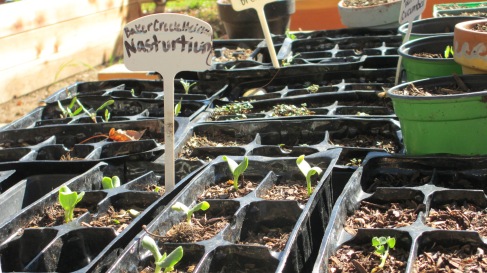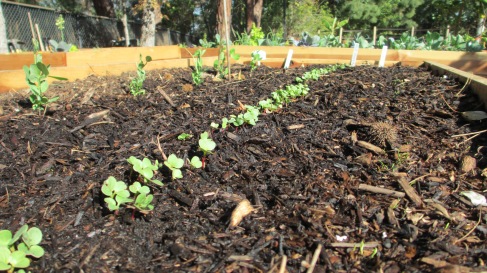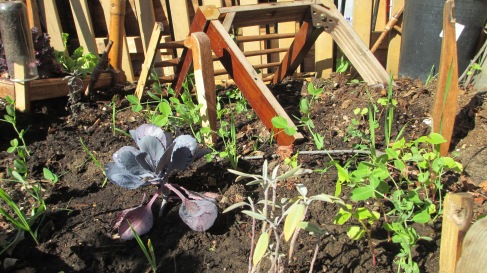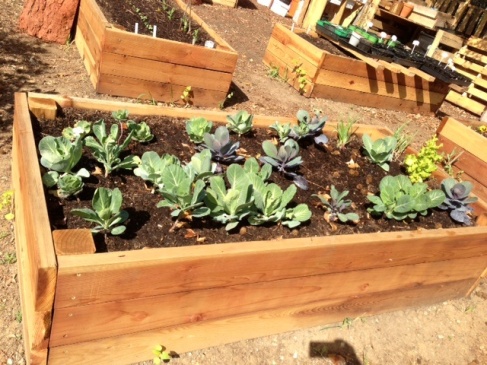February 28 – Watering
Posted: February 28, 2013 Filed under: Uncategorized | Tags: watering Leave a commentHey everyone!
Today I got to the garden around 3pm. Someone had just watered before my arrival but some of the beds looked dry already so I made sure to give them a second round since it was such a hot day!
I’ve noticed that the cabbages with curled up leaves have lots and lots of little white/gray bugs all over them. Is this normal? I forgot to take a picture, maybe the next person doing the watering can get one.
I also noticed that someone had planted a few sugar snap pea seedlings!
The leaves are completely edible and have a mild pea taste – they are great on their own, in a salad or even a stir-fry! I’m excited to see these grow. (:
There are a couple of these pea plants that have sprouted from the sides of beds, down on the ground. Since we can’t transplant them (I don’t think) we should try to help them grow upwards by putting sticks or other objects in the ground for the plant to wrap around.
Overall, everything looked good! I cleaned up the beds a little bit – picking out giant pine cones and spiky balls. The bees are still there and having a ball. It was fun/scary watching them unanimously erupt into the air as I watered the sprouts.
Book Review- Genes from the Wild
Posted: February 27, 2013 Filed under: Book reviews | Tags: assignment, Book review Leave a commentGenes from the Wild- by Robert and Christine Prescott-Allen
In this scientific research published by Earthscan, Robert and Christine Prescott-Allen discuss the benefits and costs of using wild genetic resources in agriculture as well as provide in- depth backgrounds on a variety of genetically engineered crops. Although this research was done in 1983, the issues and information are still valid and applicable in today’s context of industrial agriculture.
Wild genetic resources are the favorable and heritable traits of wild plants and animals that can be used or have potential use to people, such as in agriculture. The application of genetics in crops became dominant in the 20th century, which over the years has contributed to the dramatic increase in the production of crops in the US, including rice, sugarcane, peanuts, and soybeans. Some crops such as tomatoes would not be able to grow commercially without the help of genetic resources. The ability to take advantage of genetic variation has allowed breeders to select traits such as environmental adaptation and rapid growth, increasing the yield and allowing non-native plants to grow successfully. Most crops have benefited from breeding with wild genetic resources, such as lettuce and carrots, with the exception of a few major crops, including soybean, cabbages, and citrus fruits. In forage crops, the major benefit of using wild species is the diversity of their growing conditions, allowing the range of domesticated grass to extend to lower latitudes, used to feed livestock. Another major consideration is the category of gene pool in which gene transfer is taking place; primary, secondary, and tertiary gene pools each differs in the fertility and viability of the hybrid species and utilizes different breeding methods to achieve gene transfer.
The main plant characteristics derived from wild species include disease resistance, pest resistance, high yield, vigour, environmental adaptations, high starch and vitamins, cytoplasmic male sterility, petaloid male sterility, and harvest and transport adaptations. The most important characteristic among those would be disease resistance, exhibited by a single dominant gene. Before the use of disease resistant genes, crops suffered immense damages, such as the grassy stunt epidemic in Asia during the early 1970s. Although the gene is easily transferred, there are challenges involved in crossing; the main one is the package-deal effect, which is the common case of disease resistant genes being linked to the genes for other undesirable traits, such as bad taste. With this trade-off in mind, breeders would sometimes have to risk lowered resistance in order to maintain the quality and taste of the crops. However, there is no leeway when it comes to fungal diseases, which are the most severe in crops, making it a priority to purge them.
This research acknowledges that despite all the advantages that wild genetic resources can provide, there are also major costs to consider. Wild genes are threatened by habitat loss, over-exploitation, competition from introduced species and predators. An example is the decline of wild sunflowers in California as a result of urbanization in L.A. It’s not obvious to us that valuable gene pools are disappearing because of the appearance of species abundance. There are two ways in which a germplasm can be conserved- ex situ and in situ. Ex situ is the process of conserving resources outside of their natural habitats (e.g. zoos and gene banks). In situ conservation takes place in their native habitats (e.g. national parks). Ex situ banks are favored by most breeders, firstly, because they can be located anywhere, whereas in situ sites could be far away from breeders. Secondly, in situ banks could be subject to disturbance by poachers, firewood collectors, livestock or the destruction of the sites. Nonetheless, the priority of most conservationists is in situ conservation. In situ banks can keep everything safe in one place and are easier to protect, while ex situ collections risk loss due to human error.
I think this book offers a fair, balanced perspective on how wild genetic resources can benefit society and the importance of mitigating the consequences that entail in terms of the loss in biodiversity. What I find interesting is the difference in the ways of persuasion the authors used to address the advantages and disadvantages of wild genetic resources. They approached the advantages in the most practical and human-relevant manner, focusing on the reaping of economic and social benefits, but when they shifted their discourse to the need for conservation, their style of approach changed to one that demands altruism and insists on our inherent duty to the environment. They did not stress on how conservation can actually benefit society, which would have rendered their persuasion more effective.
Bibliography: Prescott-Allen, R; Prescott-Allen, C. (1983) Genes from the Wild: Using wild genetic resources for food and raw materials. London. Earthscan.
Watering Friday 2/22
Posted: February 25, 2013 Filed under: Uncategorized | Tags: Bees, watering Leave a commentWhoops! I forgot to post about my watering visit on Friday!
As Heather mentioned in her post, there were many bees crawling in the soil of the Baker Creek Heirloom nasturtium seedlings (see below). I couldn’t see anything special in the soil that might be attracting them, but according to a number of blogs bees love nasturtium flowers, so maybe there is something about their sprouts that they like as well.
Within a number of beds, there were little lines of sprouts coming up, such as peas, radishes, and carrots.
While watering I also found a cute little corner where a broken chair is set in the middle to serve as a trellis to the pea plants coming up.
Garden Visit Monday 2/25
Posted: February 25, 2013 Filed under: Watering Leave a commentWhen I got to the garden I saw that someone else had already watered it, but the beds already looked a little dry– it was so hot today! Anyway, here’s some things I noticed while watering/clearing out debris:
Lettuce is definitely starting to bolt, like David King explained it would:
I was wondering where the guava tree is going to go? One had fallen off, and another is still on the tree:
Some of the blueberry bushes’ leaves are starting to turn brown:
The beets and kale are starting to sprout in the bed with the big beets sign!:
There’s a plant with little white flowers growing at the side of one of the beds. It’s really pretty and I’m wondering what it is:
See you all tomorrow at the garden!
Almost Spring
Posted: February 25, 2013 Filed under: Uncategorized Leave a commentThe garden really seemed to be stepping into spring this afternoon, but it’s not quite there yet.
A few things I observed:
1. The blueberries are blossoming, with lots of white, unripe fruit. Once they start getting blue, we’ll have a lot of harvesting to do!
2. Strawberries are also beginning to show some fruit!
3. The dirt is starting to sink down because we are watering it. For example, these radishes were extended out of the dirt (not good!), so I pushed them back in. We should begin to layer more dirt/compost on top of the beds to prevent this type of problem. Whole Foods just delivered 10 tons (!!!) of compost made from tossed produce and prepared foods, and we can use some of that top refill the garden.

These radishes are growing, but they aren’t sinking with the soil! I pushed them back further into the dirt, but we will have to add more soil on top.
4. LOTS of things going to seed! We will have to pay attention to what things are going to seed. This is one of the most important parts about the garden — seed saving. It is unlikely that people will be around in the summer months to keep the garden watered and growing, we should make sure to save as much seed as we can to start again in early fall.
5. As we are going into spring, it’s getting much hotter! I noticed that the beds were really quite dry and they need to be watered a bit more, I think. Even as I was finishing watering, some of the beds and pots that I started with were already looking dry. This is hurting the herbs the most, I think. A few parsley plants had yellowing leaves, and the basil had seen better days as a result.
We will be meeting in the garden tomorrow, Tuesday the 25th, and will most likely add more dirt, do more watering, and sort through seeds. See you there!
Garden Visit
Posted: February 23, 2013 Filed under: Uncategorized Leave a commentCandace and I visited the garden on Thursday afternoon. I apologize this post is late, my account finally allowed me to add posts to the blog.
It was a beautiful day outside, perfect to go pay a visit to the garden and check on things. First, we rented out the spigot and watered all the beds. The garden has been never looked so great before! I’ve been in E3 since my freshmen year and I have not seen it like this before! We are so happy and excited to see how good the garden has been doing. Everyone keep up the hard work!
Candace and I walked around and did some weeding and checked on the beds. All the plants seemed to be doing fine. The carrots are sprouting! 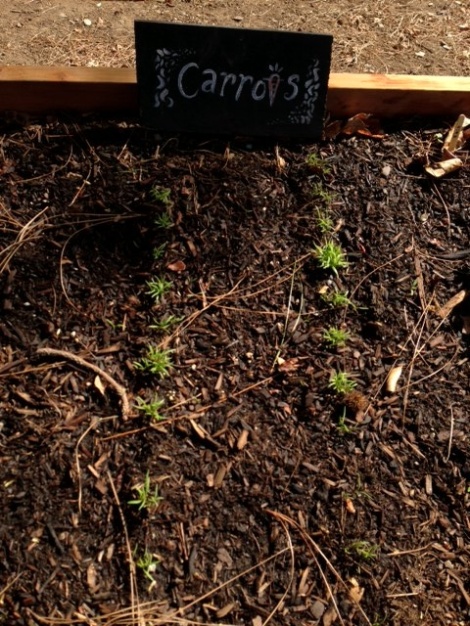
We can’t wait to see more progress in the garden!
2/22 Garden Check-In
Posted: February 22, 2013 Filed under: E3, Garden tasks, Watering | Tags: Bee, Blaise, compost, lettuce, Seeds, watering Leave a commentI wandered up to the garden this afternoon (after having come back from Garden Mentorship in Santa Monica that morning) looking forward to tending to our plants. Since they had already been watered, I walked around and weeded a bit in between beds and removed debris inside the beds.
After listening to our Seed Library guest lecture on Tuesday, I am excited to gather our lettuce seeds once they become ready.
I noticed something that I found odd in the gardens as well. There were a lot (at least six) bees walking around on our melon/tomato seedling containers. I don’t know what it is about them that attracted the bees…they have no flowers, and barely have risen above the soil line…but alas the bees liked them!
After going around to the beds and checking in on our seedlings and compost, I took a nap in the sun….then got woken up by frisbee throwers and decided to doodle on the compost containers. (I also had to re-attach Blaise’s head because it had been knocked to the floor!)
I encourage others to add some art to the garden! I’d like to make some bird feeders and signs for the garden…maybe we can have a weekend workday for garden beautification!
Dr. Vandana Shiva at UCLA
Posted: February 22, 2013 Filed under: Events, Farming | Tags: International Women's Day, UCLA Event, Vandana Shiva Leave a commentDavid King mentioned this woman during his guest lecture this past Tuesday. Lo behold the flyer I saw in my email this morning! (I’m sure those of you in the IoES mailing list also received this email.)
Here’s more information from the email for anyone who’s interested in attending Dr. Shiva’s talk.
Annual International Women’s Day Lecture featuring Vandana Shiva, philosopher, environmental activist, and ecofeminist – March 8, 6PM, UCLA
You are cordially invited to an event celebrating International Women’s Day featuring a lecture by Dr. Vandana Shiva, world-renowned philosopher, environmental activist, ecofeminist, and academic researcher on agricultural and women’s empowerment issues. Dr. Shiva’s talk for International Woman’s Day will be a CSW event as well as the keynote address of a conference titled “Global Ecologies: Nature/Narrative/Neoliberalism,” which is being organized by Elizabeth DeLoughrey, UCLA; Jill Didur, Concordia University, Canada; and Anthony Carrigan, Keele University, UK, and will take place at UCLA on March 8 and 9, 2013.
DATE: March 8
TIME: 6PM
PLACE: Broad 2160 E
FREE and OPEN TO THE PUBLIC.
TICKET REQUIRED: http://csw_vshiva.eventbrite.com
PRESENTED BY: Office of Faculty Diversity and Development, UCLA Center for the Study of Women, and the organizers of Global Ecologies
COSPONSORed BY: University of California Humanities Research Initiative, Institute for the Environment and Sustainability, and the Canadian Studies Program, the Divisions of the Humanities and Social Sciences, the Department of Gender Studies, International Institute, and the Department of English
MORE INFO: http://www.csw.ucla.edu/events/vandana-shiva
GLOBAL ECOLOGIES: http://www.csw.ucla.edu/events/global-ecologies-1
Garden Watering: Feb 19th
Posted: February 20, 2013 Filed under: Watering Leave a commentAfter the long 3-day weekend the garden was looking a little dry, but that all changed after I visited the garden early this morning (and then it rained.)
Here’s a few things I noticed:
After a few of us mapped the garden beds last week, I’m beginning to think that some of the plants we labeled as “cauliflower” might be wrong… seeing as only one of them is starting to look like a cauliflower.
2. I wanted to check up on our transplanted herbs, and they looked great!
3. This may have been there for a while, but I found this orange on the tree next to the entrance of the garden!
4. Some of our plants are bolting! David King would be proud.
Garden Watering: February 16th, 2013
Posted: February 17, 2013 Filed under: Garden tasks, Watering | Tags: Garden watering, Strawberry Leave a commentHello all.
Today was a fairly dry day, and so the plants needed extra watering. Things are looking good in the garden. A lot of the carrots seem to be growing! I also found the lone strawberry in the patch. Can’t wait until it grows more!
As I was watering, I noticed a lot of empty containers (some filled) on the left side of the garden. Are there any uses for those? I also noticed that some cabbages are getting really cramped in their spaces (especially the ones in the pots). There are 2 unused garden beds, so we should probably move them at the next garden visit.




